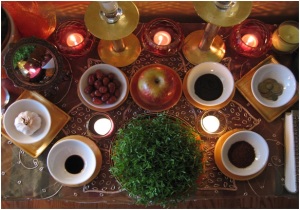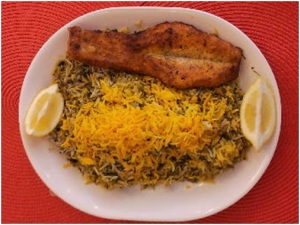You are probably wondering what is going on around you among Persian people lately or what President Barak Obama’s latest speech was about. By reading this you will find out more about today and the history behind it. Today is Iran’s New Year which is called “Nouroz.” This tradition also comes from Zoroastrians. We celebrate this day because we think that nature is coming alive again. If you pay attention around you during this time of year, you will see that the grasses are getting green again. You can see the trees growing blooms and that’s what I mean by nature coming back to life.
Did you know that Persian New Year starts at a different time each year? This is because the time is determined by when the earth turns around the sun one time. When it gets back on the same spot then it is the time that New Year happens. Last year it was in the early morning but this year it was around 11:00AM. So you can see the difference between the 2 years.
Every year, each family will set up a table which we call “Haft Sin” ( سین هفت). This word means 7 things with names that start with the sound of “s”. These 7 things are the symbols of life in Persian culture. This table includes: A special herb-like green grass (سبزه,sabze), Sea-buckthorn/Senjed, a special kind of berry (سنجد,senjed), Samanoo, a meal made out of wheat (سمنو,samano), Vinegar (سرکه,serke), Garlic (سیر,sier), and Apple(سیب,seib). We usually put other things too like goldfish, colored eggs, money, candy, etc. Sometimes people have less than 7 things and sometimes more but these 6 main things are usually on the tables.
More information about these traditional components of Haft Sin:
1. Sabzeh – (Persian: سبزه) – wheat, barley, mung bean or lentil sprouts growing in a dish – symbolizing rebirth
2. Samanu – (Persian: سمنو) – sweet pudding made from wheat germ – symbolizing affluence
3. Senjed – (Persian: سنجد) – dried oleaster Wild Olive fruit – symbolizing love
4. Sir – (Persian: سیر) – garlic – symbolizing medicine
5. Sib – (Persian: سیب )- apples – symbolizing beauty and health
6. Somāq – (Persian: سماق) – sumac fruit – symbolizing (the color of) sunrise
7. Serkeh – (Persian: سرکه) – vinegar – symbolizing old age and patience
One of our other traditions is to eat “Sabzi Polo Ba Mahi” on the New Year night. Kind of like how we eat turkey on Thanksgiving night in the United States, this food is different kinds of rice with fish.
In case you want to listen to the President’s speech about today:
http://www.youtube.com/watch?v=HfBIWh9soj8
I would like to say Happy Persian New Year to everyone who is reading this. Even if you are not Iranian it doesn’t matter, you are still in our hearts. I appreciate all of you who comment on this blog. Your comments mean a lot to me and it encourages me. Please visit this website for the next Iranian tradition that is coming up called “sinzdah be dar.”
Here are some more pictures of Nouroz and Haft Sin:
For more information about Zoroastrianism, you can see my previous post here:
https://estacyoklahoma.wordpress.com/2014/03/18/chahar-shanbeh/
You can also find even more information here:
http://www.bbc.co.uk/religion/religions/zoroastrian/





Another beautiful blog. Do you take any of the photos yourself?
I need to read this again tomorrow when it’s not so late so I can watch the President’s speech and remember to see if I can find a recipe for samanu. We already use sumac for rice and chicken.
Are the sprouts edible or decorative? They really make the table look special.
Thank you for sharing this.
Thank you for helping us learn about Iranian culture and history. The more we know the better we understand each other.
I agree! It is nice to hear people feel the same. I love to learn about people and other cultures. Thank you!